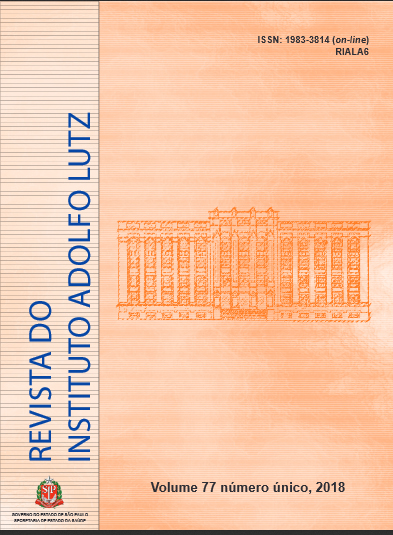Resumen
Annatto seeds present cis-bixin as the major carotenoids, but the norbixin salt is the main pigment present in dyes obtained from the alkaline extraction process. For analyzing the norbixin, the absorptions are obtained in the two spectral peaks with higher intensity, but discrepancies
in the published extinction values have led to serious doubts. Taking into account the use of absorption coefficient for evaluating the norbixin concentration in annatto seeds and extracts, the present study evaluated the absorption coefficient in various solvents and the total uncertainty associated with this value was determined. The norbixin standard was prepared from annatto seeds, purified by column chromatography and the purity of norbixin was evaluated by HPLC-DAD. The absorption coefficients were determined for norbixin in different solvents and the uncertainty was evaluated. The 0.5% potassium hydroxide, the main solvent used for marketing the annatto seeds and extracts, showed the absorption coefficients of 2887 at 454nm and of 2546 at 483nm, and the estimation of expanded uncertainty (K=2) was ±86 and 85 g 100 mL-1, respectively.
Citas
1. Bareth A, Strohmar W, Kitzelmann E. HPLC and spectrophotometric determination of annatto in cheese. Eur Food Res. Technol. 2002;215:359-64. http://dx.doi.org/ 10.1007/s00217-002-0541-y
2. Rodriguez-Amaya DB. Food carotenoids: chemistry, biology and technology, Chichester (UK):John Wiley & Sons, Ltd; 2016.
3. Tupuna DS, Paese K, Guterres SS, Jablonski A, Flôres SH, Rios AO. Encapsulation efficiency and thermal stability of norbixin microencapsulated by spray-drying using different combinations of wall materials. Ind Crops Prod. 2018;111:846-55. http://dx.doi.org/10.1016/j.indcrop.2017.12.001
4. Preston HD, Rickard MD. Extration and chemistry on annatto. Food Chem. 1980;5:47-56. http://dx.doi.org/10.1016/0308-8146(80)90063-1
5. Costa CLS, Chaves MH. Extração de pigmentos das sementes de Bixa orellana L.: uma alternativa para disciplinas experimentais de química orgânica. Quím Nova. 2005;28 (1):149-52. Disponível em: http://www.scielo.br/pdf/qn/v28n1/23053.pdf
6. Dias VM, Pilla V, Alves LP,Oliveira HPM, Munin E. Optical characterization in annatto and comercial colorific. J Fluoresc. 2011;21:415-21. http://dx.doi.org/10.1007/s10895-010-0730-1
7. Scotter MJ, Wilson LA, Appleton GP, Castle L. Analysis of annatto (Bixa orellana L.) food coloring formulations. 1. Determination of coloring components and colored thermal degradation products by high-performance liquid chromatography with photodiode array detection. J Agric Food Chem 1998;46(3):1031-8. http://dx.doi.org/10.1021/jf970063+
8. Scotter, MJ. Methods for the determination of European Union-permitted added natural colours in foods: a review. Food Addit Contam. A 2011;28(5):527-96. http://dx.doi.org/10.1080/19440049.2011.555844
9. Dean JA. Lange’s handbook of chemistry. 5.ed. St. Louis (NY):McGraw-Hill Inc;1999.
10. Reith JF, Gielen JW. Properties of bixin and norbixin and the composition of annatto extracts. J Food Sci. 1971;36(6):861-4. https://doi.org/10.1111/j.1365-2621.1971.tb15545.x
11. FAO/WHO. Specifications for the Identify and Purity of Some Food Colors, Flavours Enhancer, Thickening Agents and Certain other Food Additives. FAO Nutricion Meeting Report Series, 54B: Rome; 1975. WHO Food Additives Series, no. 7, 1975.
12. FAO/WHO. Evaluation of certain food additives and contaminants. WHO Technical Report Series, nº 683 / Joint FAO/WHO Expert Committee on Food Additives (JECFA). Geneva, Italy; 1982. Disponível em: http://apps.who.int/iris/bitstream/handle/10665/41546/WHO_TRS_683.pdf?sequence=1
13. FAO/WHO. Compendium of Food Additive Specifications. Monographs 3 / Joint FAO/WHO Expert Committee on Food Additives (JECFA), 67th meeting, Food and Agriculture Organization of the United Nations: Rome; 2006. Disponível em: http://www.fao.org/3/a-a0675e.pdf
14. Tocchini L, Mercadante AZ. Extração e determinação, por CLAE, de bixina e norbixina em coloríficos. Ciênc Tecnol Aliment. 2001;21(3):310-3. http://dx.doi.org/10.1590/S0101-20612001000300010
15. Rios AO, Mercadante AZ. Otimização para obtenção de padrão de bixina e das etapas de extração e saponificação para quantificação de bixina em snacks extrusados por CLAE. Alim Nutr. 2004;15(3):203-13.
16. Scotter M. The chemistry and analysis of annatto colouring: a review. Food Addit Contam. A2009;26(8):1123-45. http://dx.doi.org/10.1080/02652030902942873
17. Carvalho PRN, da Silva MG, Fabri EG, Tavares PER, Martins ALM, Spatti LR. Concentração de bixina e lipídios em sementes de urucum da coleção do Instituto Agronômico (IAC). Bragantia. 2010;69(3):519-24. http://dx.doi.org/10.1590/S0006-87052010000300002
18. Cardeñosa V, Lunar ML, Rubio S. Generalized and rapid supramolecular solvent-based sample treatment for the determination of annatto in food. J Chromatogr A. 2011; 1218(50):8996-9002. http://dx.doi.org/10.1016/j.chroma.2011.10.041
19. Gallardo-Cabrera C, Rojas-Barahona A. Stability study of an aqueous formulation of the annatto dyes. Int Food Res J. 2015;22(5):2149-54. Disponível em: http://www.ifrj.upm.edu.my/22%20(05)%202015/(56).pdf
20. Raddatz-Mota D, Pérez-Flores LJ, Carrari F, Insani M, Asis A, Mendoza-Espinoz a JA, León-Sánchez FD, Rivera-Cabrera F. Chemical chraracterization and quantification of the pigment extraction yield of seven mexican accessions of Bixa orellana. Rev Mex Ing Quím. 2016;15(3):727-40.
21. Rodriguez-Amaya DB, Kimura M. HarvestPlus Handbook for carotenoid analysis. HarvestPlus Technical Monograph 2. Washington, DC and Cali: International Food Policy Research Institute (IFPRI) and International Center for Tropical Agriculture (CIAT);2004.
22. Magnusson B, Örnemark U. Eurachem Guide: The Fitness for Purpose of Analytical Methods – A Laboratory Guide to Method Validation and Related Topics, 2. ed.;2014. [acesso 2015 Jun 03]. Disponível em: https://www.eurachem.org/images/stories/Guides/pdf/MV_guide_2nd_ed_EN.pdf
23. Scotter MJ, Thorpe SA, Reynolds SL, Wilson LA, Strutt PR. Characterization of the principal colouring components of annatto using high performance liquid chromatography with photodiode-array detection. Food Addit Contam. 1994;11(3):301-315. http://dx.doi.org/10.1080/02652039409374229
24. Pretsch E, Bühlmann P, Badertscher M. Structure Determination of Organic Compounds – Table of Spectral Date. 4.ed. Verlag Berlin Heidelberg: Springer; 2009.
25. Carey FA. Química Orgânica. 7.ed., vol. 2. Porto Alegre: AMGH Editora Ltda; 2011.
26. FAO/WHO. Compendium of Food Additive Specifications. Addendum 11 / Joint FAO/WHO Expert Committee on Food Additives (JECFA), 61th meeting, Food and Agriculture Organization of the United Nations: Rome; 2003.
27. Ellison SLR., Williams A. Eurachem/CITAC guide: Quantifying Uncertainty in Analytical Measurement. 3.ed; 2012. [acesso 2015 Jun 03]. Disponível em: https://www.eurachem.org/images/stories/Guides/pdf/QUAM2012_P1.pdf

Esta obra está bajo una licencia internacional Creative Commons Atribución 4.0.
Derechos de autor 2018 Marta Gomes da Silva, Adão Luiz Garcia, Enieluce Santos Brito, Paulo Roberto Nogueira Carvalho
